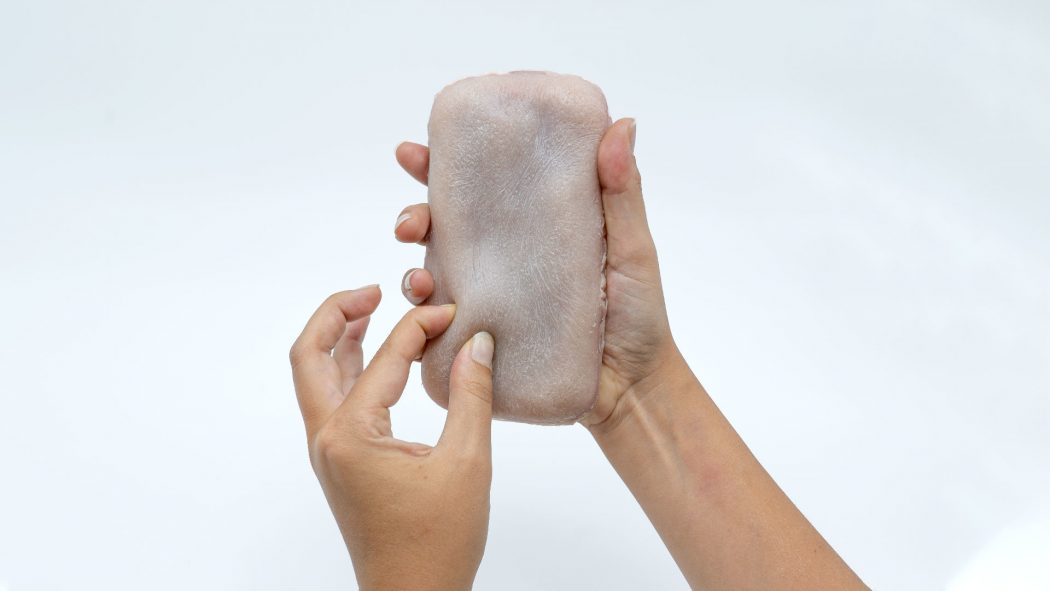Artificial skin is nothing new. Having been used in robotics, cosmetic testing, and medical rehabilitation, it’s already seen a variety of uses in multiple applications. What is new, however, is having skin on the back of your phone.
Though still a prototype, Skin-On Interface, developed at the University of Bristol in partnership with Telecomm ParisTech and Sorbonne University, attracted media attention this past October for their release of an ultra-realistic albeit slightly unnerving phone case covered in artificial human skin. Although it mostly captured attention for its appearance, its functionality and response to touch was noteworthy as well.
“The idea is perhaps a bit surprising, but skin is an interface we are highly familiar with so why not use it and its richness with the devices we use every day?” commented Dr. Anne Roudaut, the research supervisor for this project.
Indeed, this concept is what inspired lead author Marc Teyssier in designing an interface that could mimic human skin in both appearance and sensing. Believing that gadgets today have created a “cold” and impersonal human-machine interaction that has removed the ability to convey emotions and enrich discourse, Teyssier and his team wanted to replace such interactions with a more natural, intuitive experience. For this reason, they sought to provide users with an immersive experience using a gadget that could attach to their phones, smartwatches, and laptop touch pads.
“Believing that gadgets today have created a ‘cold’ and impersonal human-machine interaction that has removed the ability to convey emotions and enrich discourse, Teyssier and his team wanted to replace such interactions with a more natural, intuitive experience.”
Being able to respond to touch and pressure, Skin-On is essentially a multi-layer membrane of electrodes and conductive thread sandwiched between silicone sheets. Teyssier drew inspiration from the texture, malleability, responsiveness, and sensitivity of skin to its surroundings to create a technology that could enhance the ease with which users communicate with their devices through gestures. Such gestures are “felt” by the model and translated into actions on the device.
“’We have seen many works trying to augment human with parts of machines,’” explains Roudaut. “’Here we look at the other way around and try to make the devices we use every day more like us, i.e. human-like.’”
In this way, device usage, especially that of phones, is effectively streamlined since interactions with the back of the case allow users to communicate a desired effect and “produce” a specific outcome. Pinching the case, for example, translates into zooming in while twisting changes the volume. What’s more, Skin-On can also “detect” emotion and react accordingly. A sudden firm grip indicates anger, tickling signifies laughter, and stroking implies comfort. Upon recognizing these gestures, the device then responds, such as by sending an emoji through text.
“We have seen many works trying to augment human with parts of machines,” explains Roudaut. “Here we look at the other way around and try to make the devices we use every day more like us, i.e. human-like.”
In terms of usage, though Teyssier has no plans on marketing the Skin-On Interface, its design could have big implications in the advancement of human-machine interaction. Since synthetic skin is already being used to develop human-like robots and realistic prostheses, technology similar to Skin-On can help further enhance the replication of human senses and capabilities. In more everyday applications, though, this type of interface could help heighten the experience of virtual and augmented reality. At Northwestern University in the US and Hong Kong Polytechnic University, for example, researchers have developed a haptic patch, also resembling skin, that adheres to human skin and transmits mechanical vibrations, thus replicating the feeling of touch over long distances and allowing such actions as a parent “holding” their child. In this way, an entirely new dimension could be added to VR.
“Although there is still plenty of room to improve in the way of artificial skin, it’s nothing short of impressive how well these models replicate the human senses and the potential they hold in further advancing future technologies.”
“If you take a look at what exists today in VR and AR, it consists primarily of auditory and visual channels,” illustrates John A. Rogers, one of the scientists involved in the patch’s creation. “But we think that the skin itself – the sense of touch – could qualitatively add to your experience that you could achieve with VR, beyond anything that’s possible with audio and video.”
Although there is still plenty of room to improve in the way of artificial skin, it’s nothing short of impressive how well these models replicate the human senses and the potential they hold in further advancing future technologies. In fact, current projects are already aiming to develop models that are lighter, thinner, more flexible, and more sensitive. For the near future, though, you can expect to find Teyssier creating a more realistic version of the Skin-On Interface, one he hopes will be embedded with hair and temperature.








